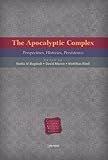The Apocalyptic Complex : Perspectives, Histories, Persistence / ed. by Nadia Al-Bagdadi, Matthias Riedl, David Marno.
Material type: TextPublisher: Budapest ; New York : Central European University Press, [2018]Copyright date: 2018Description: 1 online resource (432 p.)Content type:
TextPublisher: Budapest ; New York : Central European University Press, [2018]Copyright date: 2018Description: 1 online resource (432 p.)Content type: - 9786155225383
- 202/.3 23
- BS646 .A6346 2018
- online - DeGruyter
| Item type | Current library | Call number | URL | Status | Notes | Barcode | |
|---|---|---|---|---|---|---|---|
 eBook
eBook
|
Biblioteca "Angelicum" Pont. Univ. S.Tommaso d'Aquino Nuvola online | online - DeGruyter (Browse shelf(Opens below)) | Online access | Not for loan (Accesso limitato) | Accesso per gli utenti autorizzati / Access for authorized users | (dgr)9786155225383 |
Browsing Biblioteca "Angelicum" Pont. Univ. S.Tommaso d'Aquino shelves, Shelving location: Nuvola online Close shelf browser (Hides shelf browser)
Frontmatter -- Table of Contents -- Introduction. The Resilience of the Apocalyptic -- Part I. Perspectives -- The Varieties of Millennial Experience -- Apocalyptic Violence -- The Psychology of Apocalypticism -- Part II. The Middle Ages -- The Chained Messiah: The Taming of the Apocalyptic Complex in Jewish Mystical Eschatology -- God’s Chronography and Dissipative Time -- Christendom, Crusade, and the End of Days: The Dream of World Conversion (1099–1274) -- From the Last Emperor to the Sleeping Emperor: The Evolution of a Myth -- Part III. Transformations -- Radical Hopes: Apocalyptic Longing in Nineteenth-Century Philosophy -- Political Religions, Apocalypticism, and the End of History: Some Considerations -- Eve’s Last Dream -- Part IV. Persistence -- Ukrainian Millennialism: A Historical Overview -- Abu Muș‘ab Al-Sūrī and Abu Muș‘ab Al-Zarqawī: The Apocalyptic Theorist and the Apocalyptic Practitioner -- “His Dark Materials.” The Early Apocalypticism of Enoch Recycled in Modern and Postmodern Times -- Appendices -- Appendix I. Elements of Online Apocalypticism -- Appendix II. Select Bibliography for the Study of Apocalypticism -- About the Authors -- Index
restricted access online access with authorization star
http://purl.org/coar/access_right/c_16ec
The attack on the World Trade Center in 2001, followed by similarly dreadful acts of terror, prompted a new interest in the field of the apocalyptic. There is a steady output of literature on the subject (also referred to as “the End Times.) This book analyzes this continuously published literature and opens up a new perspective on these views of the apocalypse. The thirteen essays in this volume focus on the dimensions, consequences and transformations of Apocalypticism. The authors explore the everyday relevance of the apocalyptic in contemporary society, culture, and politics, side by side with the various histories of apocalyptic ideas and movements. In particular, they seek to better understand the ways in which perceptions of the apocalypse diverge in the American, European, and Arab worlds. Leading experts in the field re-evaluate some of the traditional views on the apocalypse in light of recent political and cultural events, and, go beyond empirical facts to reconsider the potential of the apocalyptic. This last point is the focal point of the book.
Mode of access: Internet via World Wide Web.
In English.
Description based on online resource; title from PDF title page (publisher's Web site, viewed 20. Nov 2024)









